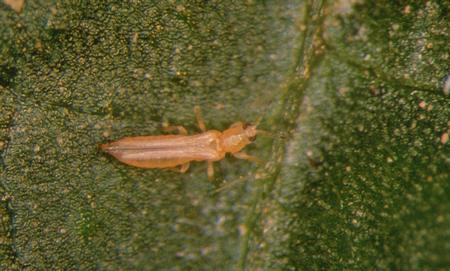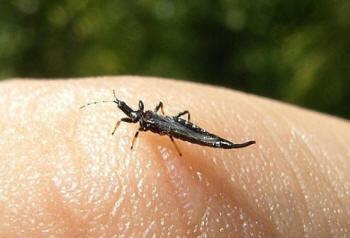Yikes, thrips!
-
A couple of years ago, I noticed that my beautiful Sasanqua camellias were suddenly looking wretched. Their normally shiny green leaves were turning pale or silvery in places, and many were falling off. When I turned over an individual leaf, the underside was caked with raised black spots. Thrips had taken up residence and were sucking the juices out of the leaves. These insects puncture the surface of the leaf and suck out the cell contents, discoloring the leaf and leaving black varnish-like flecks of excrement.
 Western flower thrip. Photo: Wikimedia Commons
Western flower thrip. Photo: Wikimedia CommonsThrips feed in large groups and individual insects (less than 1-20th inch long) are difficult to identify without a hand lens. There are numerous types of thrips that are attracted to specific plant families. Some thrips are even beneficial predators. Heliothrips haemorrhoidalis, or greenhouse thrips, are the ones fond of rhododendrons, azaleas and camellias. They can also be found on avocado, crotons, photinia, viburnum, dogwood, dahlias, laurel and other ornamentals.
I rarely encounter a gardener who has not experienced the frustration of thrips in his or her garden. So, what’s the solution? Unfortunately, there is no one-size-fits-all remedy. UC Marin Master Gardeners promote the use of integrated pest management (IPM) to address garden challenges (you can check out UC’s IPM guidelines for thrips here). Basically, this means starting with the most natural and least toxic methods of preventing or eliminating pest problems. Ponticulothrips diospyrosi. Photo: Wikimedia Commons
Ponticulothrips diospyrosi. Photo: Wikimedia CommonsThe basic first step is right plant, right place. Many garden challenges can be prevented by making an informed choice while you’re still at the nursery. Read the plant labels and note basic requirements such as sun or shade, and water needs. A plant that is stressed by its living conditions is going to be weakened and less able to fend off insects.
Regular garden maintenance is key to thrips control. Monitor your garden regularly and look closely for signs of infestation. Be sure to check the underside of leaves. If the dreaded insects are discovered, remove all affected leaves and flowers (a big job, but one that will greatly increase your chances of controlling the insect spread). Be sure to collect the dead leaves around the plant as insects will continue to live and reproduce in the soil and debris. Consider releasing beneficial insects such as ladybugs, lacewings and minute pirate bugs. Hose off the plants with a strong water spray to reduce insect populations prior to “good bug” release.
If these least-toxic methods are not successful, consider next steps: the introduction of the least-toxic pesticide control specifically identified with thrips management. Applications of sprays containing horticultural oils, natural pyrethrins or insecticidal soaps are good choices. It is important to spray the underside of the leaf and the soil around the plant. Several applications may be necessary. Follow the instructions on the bottle. If, after several rounds of thorough spraying, there is still not a noticeable reduction in the thrips population, you could consider using a spray containing Spinosad. While effective at controlling thrips, it is also toxic to some beneficial insects and bees for about one day after application. Avoid using this product when the plants are flowering.
Even more disruptive to the good bug and pollinator population are neonicotinoids and systemic insecticides. Rather than considering these controls, you might want to remove the thrips magnet and plant something new, wonderful, and more pest- and disease-resistant.
I’m not quite ready to give up on my camellias and rhodies. I have learned to tolerate the presence of some thrips. I’m working hard at monitoring the plants, removing infected leaves and blooms, and making sure I am meeting the cultural needs of these beloved plants.


